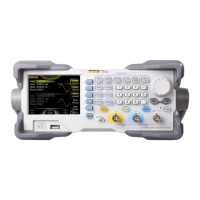Chapter 2 Performance Verification Test RIGOL
DG1000Z Performance Verification Guide
Spurious Signal Test
Specification:
Sine Wave Spectrum Purity (Typical 0dBm)
Spurious signal
(non-harmonic)
Typical (0dBm)
≤10MHz: <-70dBc
>10MHz: <-70dBc+6dB/octave
[1]
Note
[1]
: 6 dBc/octave means that when the frequency doubles, the specification increases by 6 dBc. For example,
when the output frequency of DG1000Z is 10MHz, the specification is <-70dBc and when the output
frequency is 30MHz, the specification is <-70dBc+2×6dBc, namely <-58dBc.
Test Procedures:
1. Make sure that the environment temperature is between 18℃ and 28℃ and
DG1000Z has been warmed up for at least 30 minutes. Connect the channel
output terminal (take CH1 as an example; the test method is also applicable to
CH2) of DG1000Z with the RF input terminal of the spectrum analyzer using a
dual-BNC cable and N-BNC adaptor as shown in Figure 2-4.
2. Turn on DG1000Z. Press Utility Set To Default OK to restore DG1000Z
to the factory setting.
3. Set DG1000Z:
a) Set the output impedance of CH1 to 50Ω (press Utility Channel Set
Output Set Imped and select “Load”).
b) Set the output waveform of CH1 to a sine waveform with 5MHz frequency,
0dBm amplitude and 0V
DC
offset.
d) Press Output1 to turn on the output of CH1.
4. Turn on and set the spectrum analyzer:
a) Set the reference level to 10dBm and input attenuation to 20dB.
b) Set the start frequency to 0Hz and stop frequency to 30MHz.
c) Set the resolution bandwidth to 1kHz.
d) Set the peak offset to 3dB.
e) Set the sweep mode to single.

